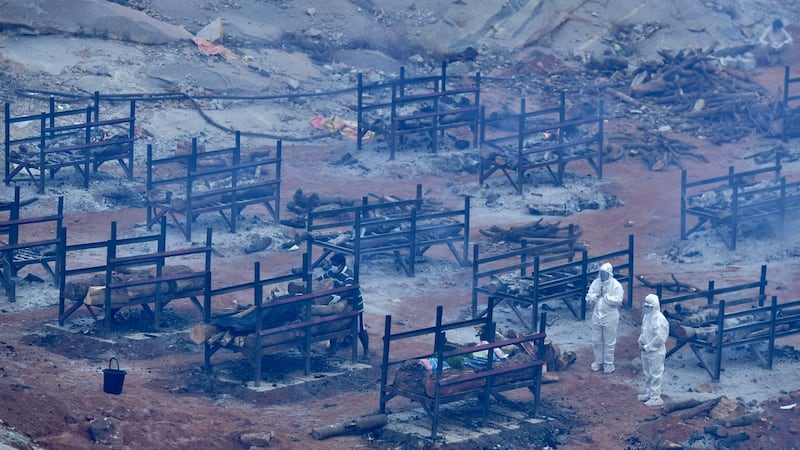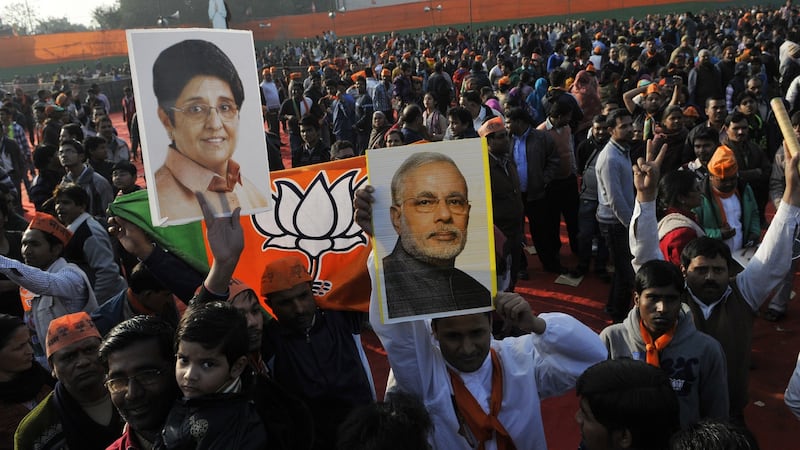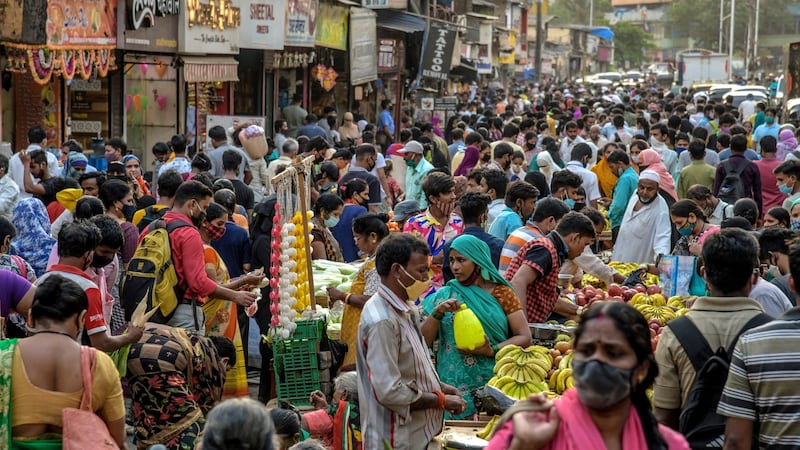His Covid-19 taskforce didn't meet for months. His minister for health assured the public in March that India had reached the pandemic's "endgame". A few weeks before that, prime minister Narendra Modi boasted to global leaders that his nation had triumphed over coronavirus.
India “saved humanity from a big disaster by containing corona effectively”, Modi told a virtual gathering at the World Economic Forum in late January, three tricolour Indian flags displayed in the background. Now, a second wave has made India the worst-hit country in the world.
New infections have reached about 400,000 a day. Vaccines are running short. Hospitals are swamped. Lifesaving oxygen is running out. Each day, cremation grounds burn thousands of bodies, sending up never-ending plumes of ash that are turning the skies grey over some of India’s biggest cities.
India’s stark reversal, from declaring victory to suffering its gravest emergency in decades, has forced a national reckoning, with Modi at its centre. Experts around the world once marvelled at how the country seemed to have escaped the worst of the pandemic, entertaining explanations about the relative youth and health of the population that Modi and his government embraced, if not encouraged.
Even now, Modi’s supporters say that India has been hit by a global phenomenon and that more time is needed to trace the causes of the second wave.
But independent health experts and political analysts say Modi’s overconfidence and his domineering leadership style bear a huge share of the responsibility. Critics say his administration was determined to cast an image of India as back on track and open for business despite lingering risks. At one point, officials dismissed warnings by scientists that India’s population remained vulnerable and had not achieved “herd immunity”, as some in his administration were suggesting, said people familiar with those conversations.
Growing distress
The growing distress across India has tarnished Modi’s aura of political invulnerability, which he won by steamrolling the opposition and leveraging his personal charisma to become India’s most powerful politician in decades. Opposition leaders are on the attack, and his central hold on power has increasingly made him the target of scathing criticism online.
With parliamentary elections three years away and no signs of defections from his government, Modi’s power seems secure. His government has stepped up efforts to get supplies to desperate patients and broadened eligibility for scarce vaccines to more age groups. Still, analysts say that his dominance means that more people will hold him personally responsible for the sickness and death exploding across the country.
Although India is a vaccine powerhouse, producing vaccines to protect the world, it didn't purchase enough doses to protect itself. Instead, while vaccination rates remained low at home, New Delhi exported more than 60 million shots to bolster its standing on the world stage.

Even as infections rose, Modi let big groups gather to help his ruling Bharatiya Janata Party and burnish its Hindu nationalist credentials. His government allowed a Hindu festival with millions of worshippers to take place. He campaigned in state elections without a mask at rallies of thousands of maskless supporters.
Modi surrounded himself with allies rather than experts, analysts said. Officials felt too intimidated to point out mistakes, the analysts said, or to call into doubt his claims that the pandemic was over. His party and his allies have also moved to silence critics, ordering Facebook, Instagram and Twitter to take down critical posts and threatening to arrest people for pleading for oxygen.
Modi’s party, known as the BJP, and the government declined to answer specific questions but listed actions the government has taken, including Modi holding more than a dozen meetings in April with air force officers, pharmaceutical executives and many others.
In a statement, the government said it “maintained a steady pace of co-ordination and consultation to prepare an adequate response”. It added that the administration in February had “advised states to maintain strict vigil” and “not let their guard down”.
On Sunday, the country reported 392,488 new virus infections and more than 3,689 deaths. Evidence suggests the official numbers vastly understate the toll. The country's biggest city, Mumbai, halted all vaccinations because it essentially ran out.

Analysts say Modi performed much better during the first wave. A longtime politician with humble roots and a penchant for dramatic moves, Modi (70), embraced masks and social distancing from the earliest days. On March 24th, 2020, when India had fewer than 600 total reported infections, Modi ordered his country into one of the strictest lockdowns in the world at four hours’ notice. Most people dutifully stayed indoors. When Modi asked citizens to stand on their balconies and bang pots and pans in solidarity with healthcare workers, millions did just that.
Experts credit that lockdown, though flawed, with slowing the spread. But the restrictions were economically devastating, putting tens of millions out of work and imperilling many of Modi’s grandest ambitions, including turning India into a global power. He became fearful of locking down again.
After he eased many restrictions, infections rose, reaching almost 100,000 per day in September, but the healthcare system held. By the beginning of 2021, when infections had ebbed and the economy began to stagger to life, Modi and his team made a concerted effort to signal that India was back.
Many Indians shed their masks. They returned to markets and socialised. Even more restrictions were lifted. Covid-19 centres set up during the first wave were dismantled. His party’s leadership declared in February that India had “defeated Covid under the able, sensitive, committed and visionary leadership of prime minister Shri Narendra Modi”. In early March, Harsh Vardhan, India’s health minister, proclaimed India was “in the endgame of the Covid-19 pandemic”.
Vaccination programme
Those who weren’t so sure were sidelined. India’s Covid-19 taskforce, which includes about 20 health professionals, had been meeting at least twice a month. But between January 11th and April 15th, the taskforce did not meet at all, according to three people with knowledge of their deliberations. Two said that the government simply believed the threat had passed.

The vaccination programme lost steam as complacency set in. The Modi administration began exporting Indian-made vaccines to gain favour with neighbours who might be tempted to take vaccines from China, New Delhi's regional rival. The government approved only two vaccines for use, both made in India, touting the country's self-sufficiency. Less than 2 per cent of the population has received two doses.
Rajeev Chandrasekhar, a spokesman for the BJP, said there were no shortages when the government exported vaccines and that "the government proactively has expanded production and procurement from alternate sources". As vaccinations sputtered, Modi hit the campaign trail.
Several states were holding elections, and he focused specifically on West Bengal, a state controlled by an opposition party. Until mid-April, Modi and Amit Shah, the home minister, campaigned relentlessly, drawing crowds of thousands, many not wearing masks and packed closely together. Results of the vote are expected on Sunday.
Although health experts warned of risks, Modi, an energetic campaigner, seemed to draw strength from the rallies. He told one in mid-April, as India topped 200,000 new daily infections, how happy he was to “see only people and people and nothing else”.
Laboratories in West Bengal are reporting a positivity rate of 50 per cent, meaning half the people tested have been infected. Other states holding elections are seeing spikes.
Modi is likely to hold on to power, thanks to weak opposition and his ability to fire up his Hindu nationalist base. Even his image has changed; Modi has lost the baseball cap and chic sunglasses he wore a year ago and grown his hair and beard long, reminiscent for some of a Hindu sage.
"He's just a unique political animal," said Milan Vaishnav, director of the South Asia programme at the Carnegie Endowment for International Peace. "He has this charisma, an allure, a magnetism, a very compelling personal story, and he has enormous personal credibility with the average voter." Even now, Vaishnav added, "people like Modi, and they will find ways to justify it".
– New York Times








